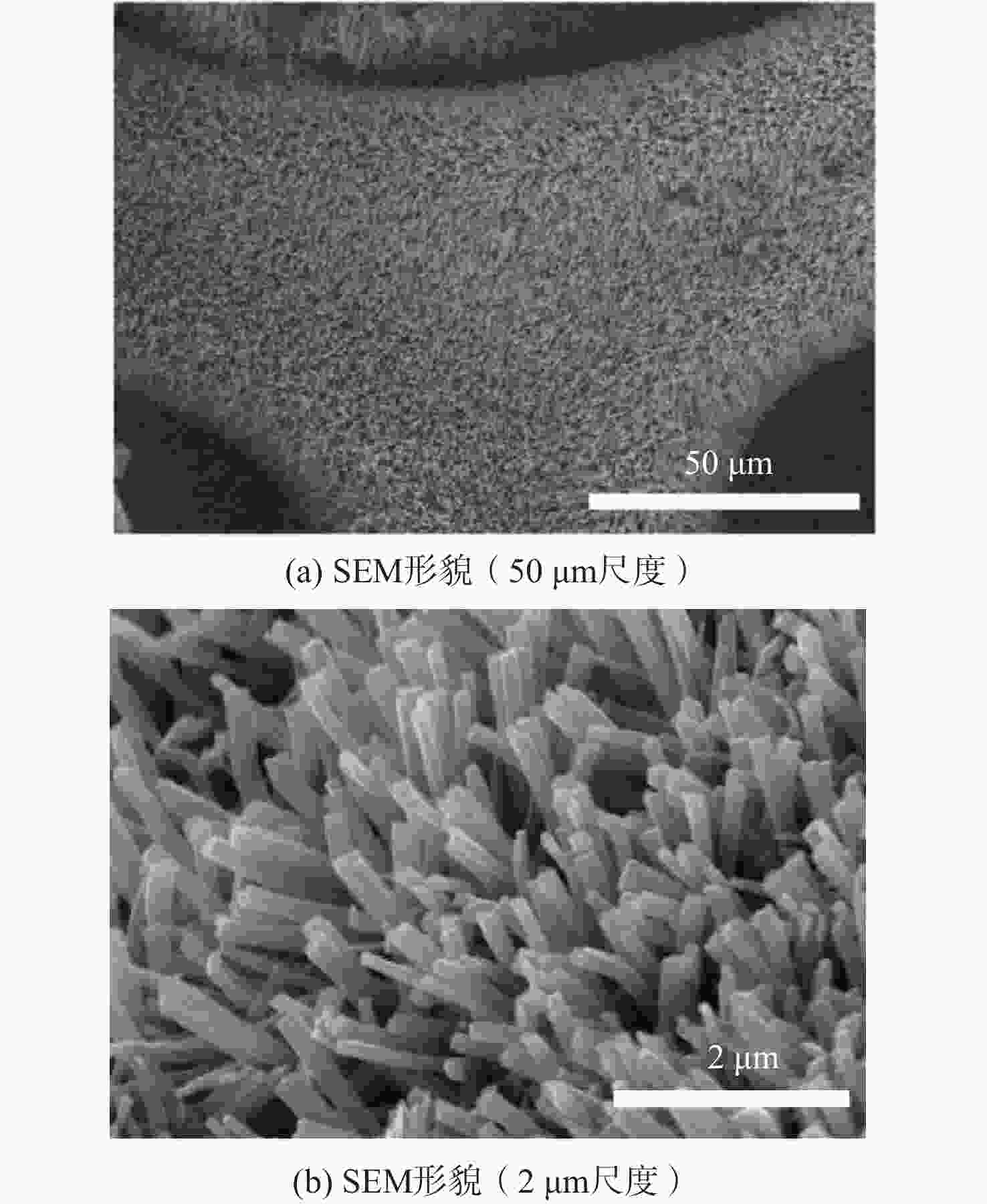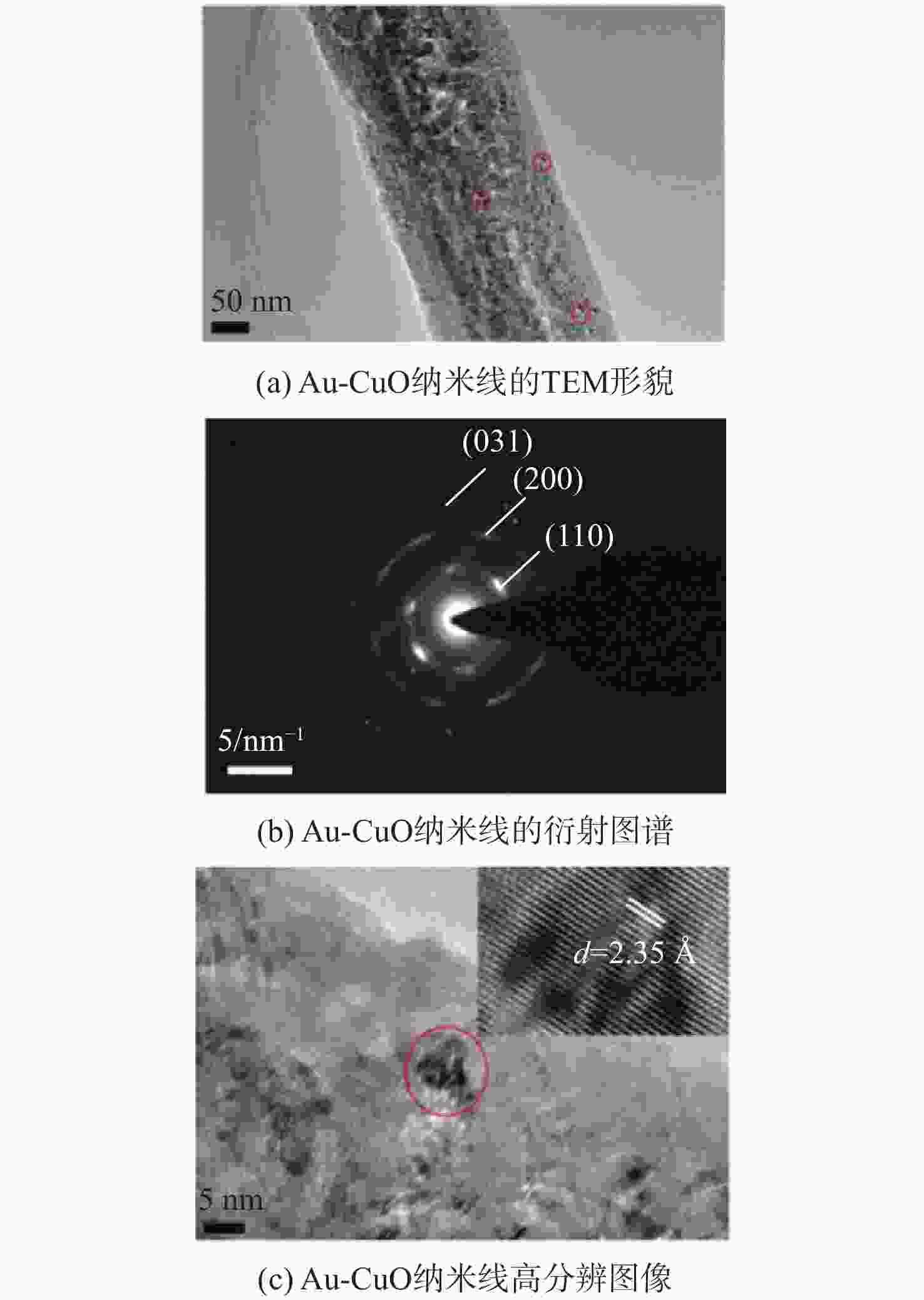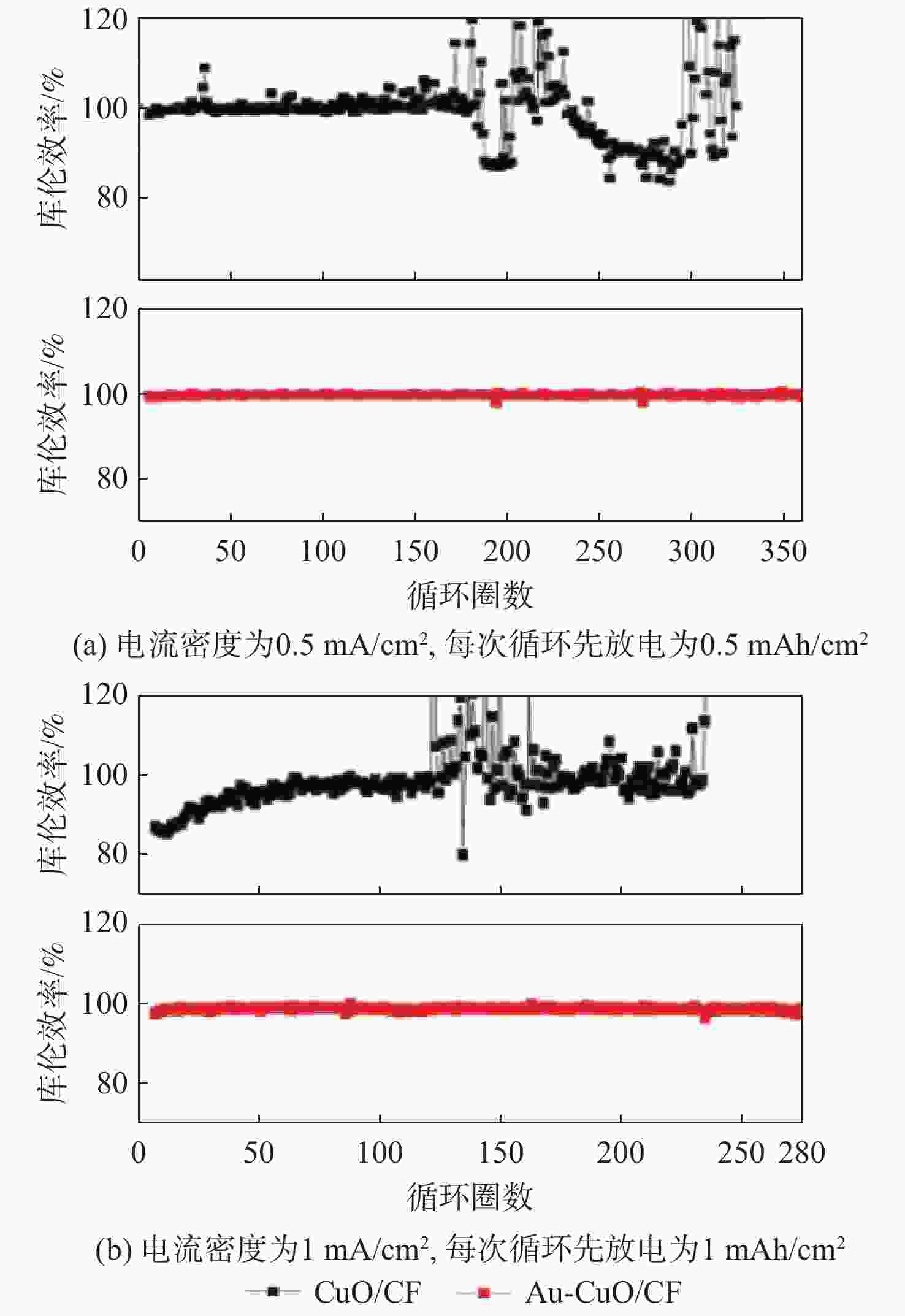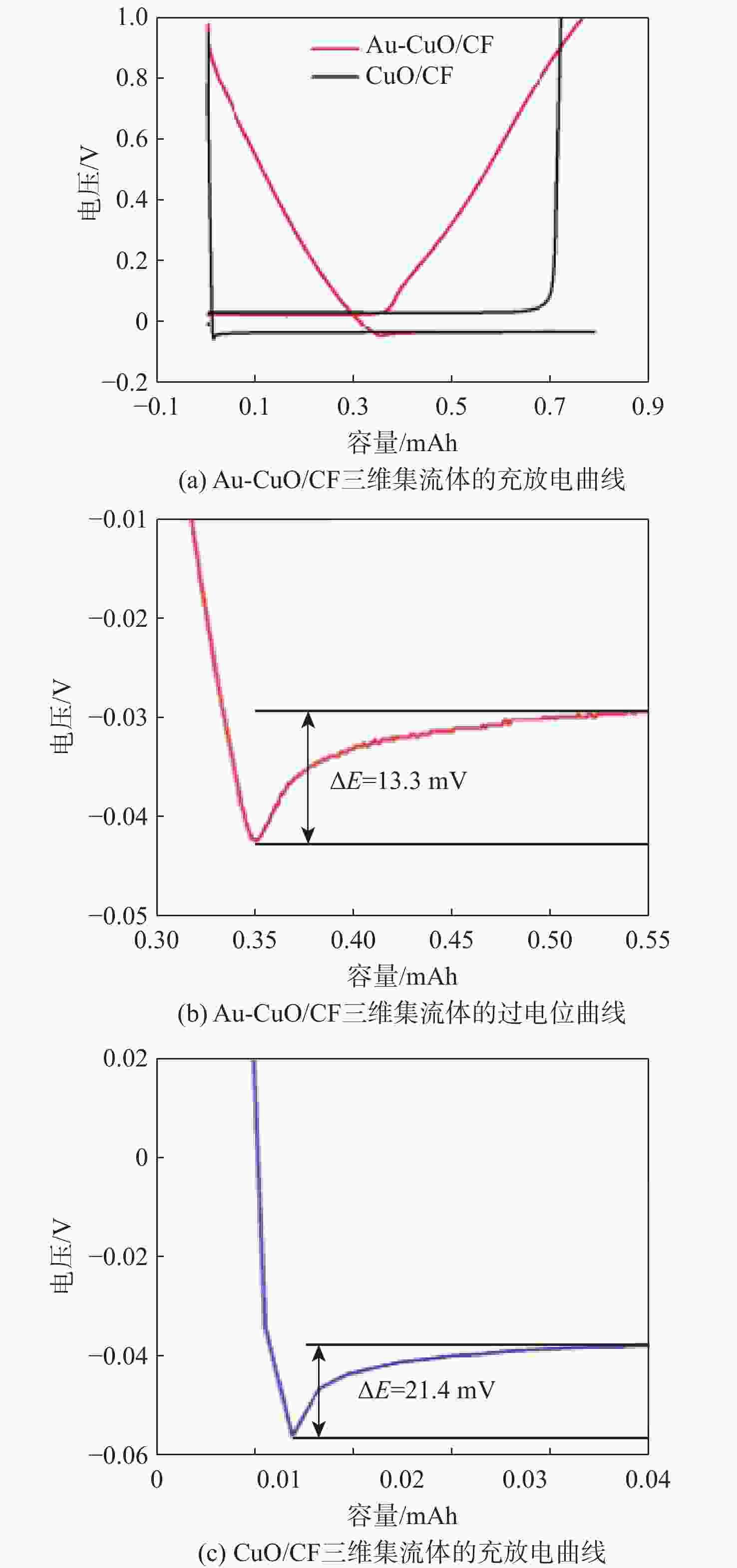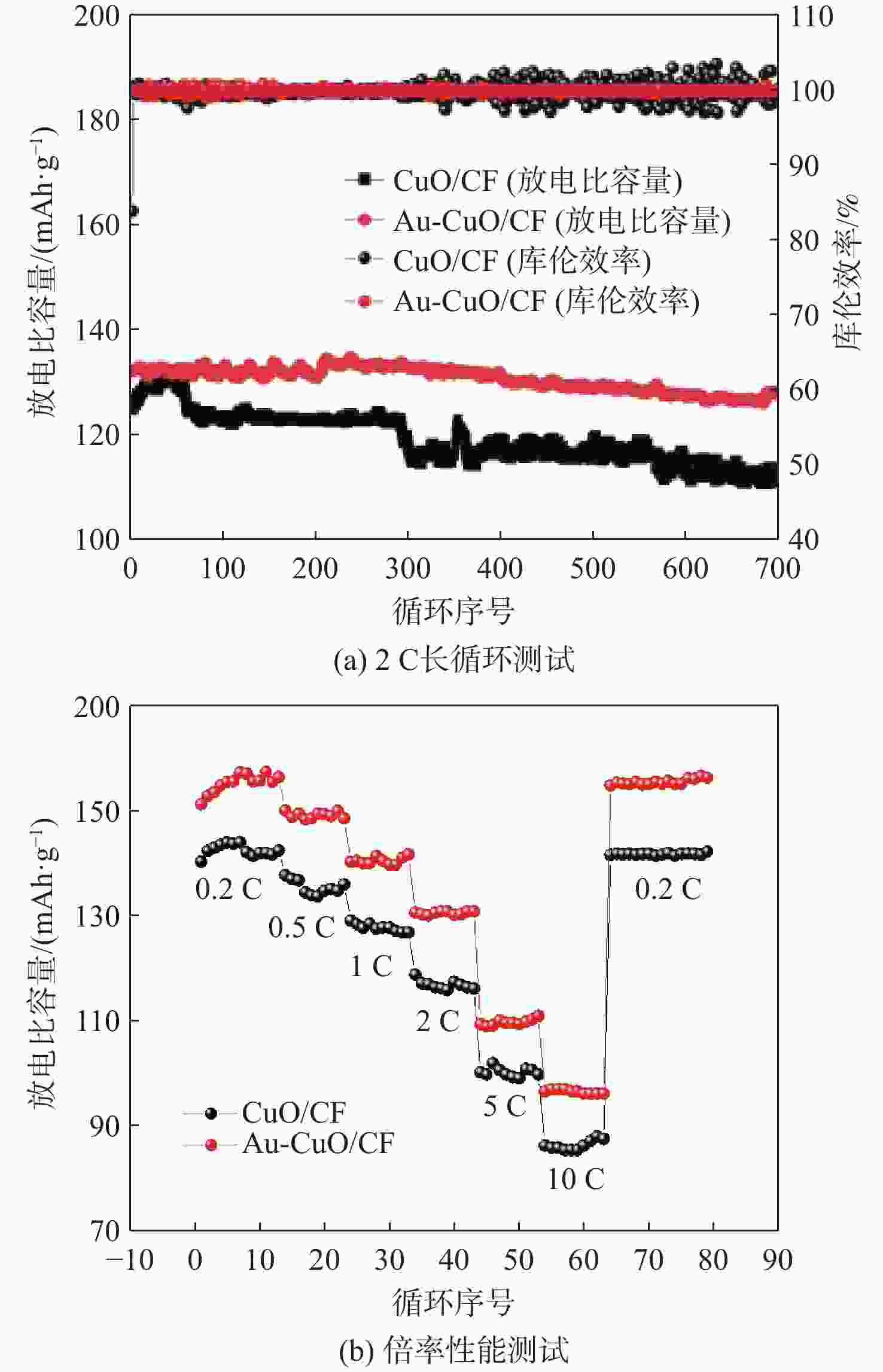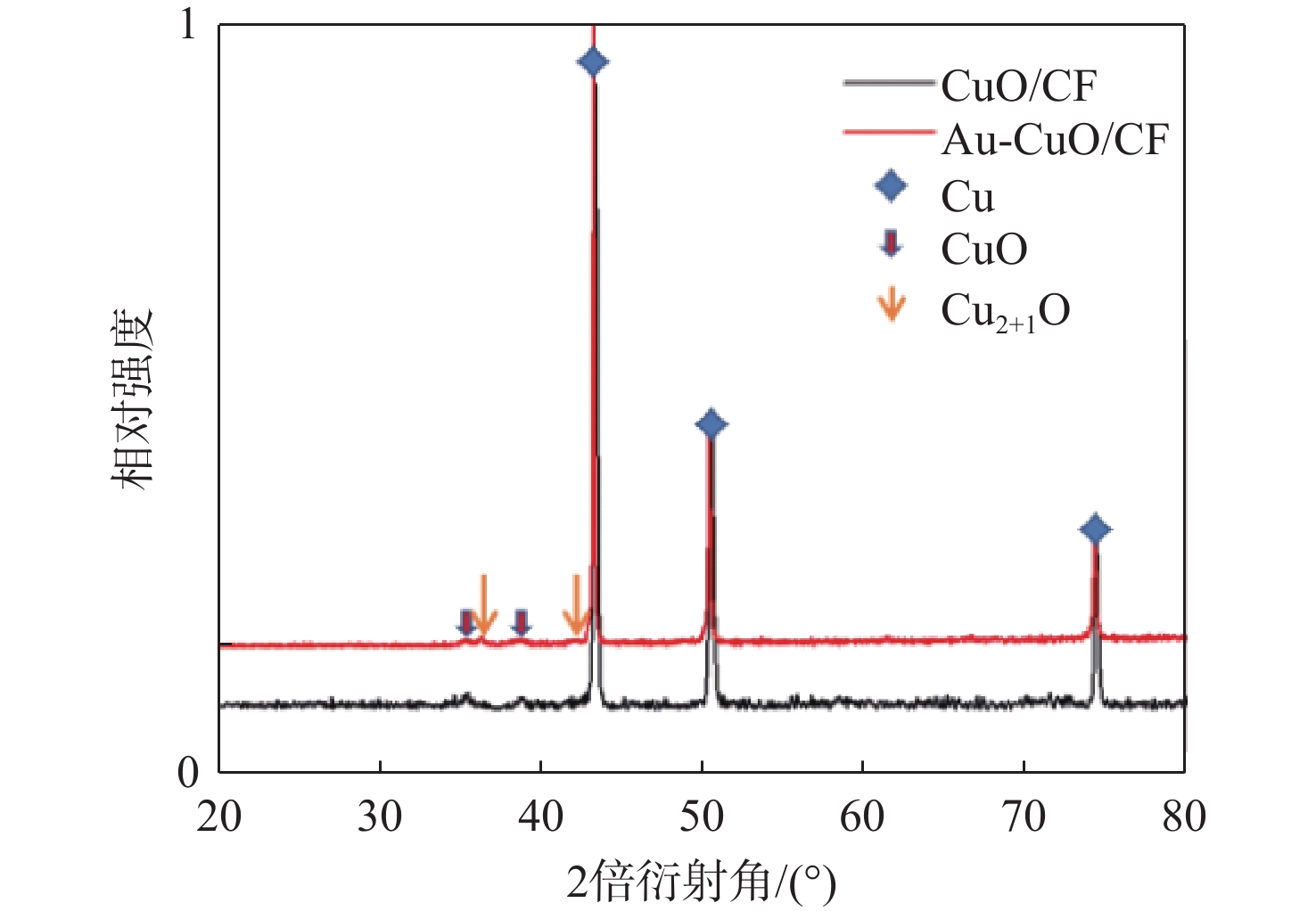-
摘要:
随着临近空间飞行器的战略地位日渐增长,其对大功率、高比能、长循环储能电池体系的需求也不断提高,锂金属电池具有超高的理论容量,有望成为新一代临近空间飞行器储能电池的有力候选者。锂金属电极具有极低的氧化还原电位、较高的理论容量,但锂枝晶生长带来的各种问题一直制约着锂金属负极的应用。基于氧化刻蚀和离子交换原理,在泡沫铜(CF)上制备CuO纳米线阵列并引入Au作为亲锂位点,成功构建了Au-CuO/CF纳米阵列三维(3D)集流体并应用于锂金属电池负极,其库伦效率、循环寿命及循环稳定性均明显优于未经修饰的CuO/CF纳米阵列三维集流体,与磷酸铁锂正极(LFP)组成全电池后放电比容量高于CuO/CF纳米阵列三维集流体并在700圈循环后仍有高达97.7%的容量保持率。Au-CuO/CF纳米阵列三维集流体制备工艺简单,电化学性能优异,全电池更表现出稳定的循环性能和极高的容量保持能力,具有成为下一代高比能量锂金属电池负极集流体的应用潜力。
Abstract:With the growing strategic position of near-space vehicles, the demand for energy storage batteries with high power, high specific energy, and long cycle life has also increased. Lithium metal battery with ultra-high theoretical specific energy is a promising candidate for the next-generation energy storage system of near-space vehicles. Lithium metal exhibits extremely low reduction potential and high theoretical capacity, but its application is limited by issues associated with dendrite growth. In this paper, based on oxidation etching and ion exchange mechanism, a three-dimensional (3D) Au-CuO nanowire array current collector on copper foam (CF) (Au-CuO/CF nanoarray 3D current collector) was successfully prepared via the preparation of CuO nanowire array on CF and the introduction of Au as lithophilic sites. This current collector was then applied as a lithium metal battery anode. Compared to the CuO/CF nanoarray 3D current collector, the Au-CuO/CF nanoarray 3D current collector demonstrated significantly improved Coulombic efficiency, cycle life, and cycling stability. When paired with a lithium iron phosphate (LFP) cathode, the full cell achieved a capacity retention of 97.7% after 700 cycles. The Au-CuO/CF nanoarray 3D current collector features simple preparation and excellent electrochemical performance, with the full cell demonstrating outstanding cycling stability and exceptional capacity retention, showing great potential as a next-generation high-energy-density lithium metal battery anode current collector.
-
-
[1] 南海阳, 韩晓明, 刘洪引, 等. 国外临近空间飞行器发展现状及趋势[J]. 飞航导弹, 2014(10): 3-8.NAN H Y, HAN X M, LIU H Y, et al. Development status and trend of near spacecraft abroad[J]. Aerodynamic Missile Journal, 2014(10): 3-8(in Chinese). [2] 张海林, 周林, 马骁, 等. 临近空间飞行器发展现状及军事应用研究[J]. 飞航导弹, 2014(7): 3-7.ZHANG H L, ZHOU L, MA X, et al. Research on development status and military application of near space vehicles[J]. Aerodynamic Missile Journal, 2014(7): 3-7(in Chinese). [3] 王亚飞, 安永旺, 杨继何. 临近空间飞行器的现状及发展趋势[J]. 国防技术基础, 2010(1): 33-37.WANG Y F, AN Y W, YANG J H. Present situation and development trend of near-space vehicles[J]. Technology Foundation of National Defence, 2010(1): 33-37(in Chinese). [4] 聂万胜, 罗世彬, 丰松江, 等. 近空间飞行器关键技术及其发展趋势分析[J]. 国防科技大学学报, 2012, 34(2): 107-113. doi: 10.3969/j.issn.1001-2486.2012.02.023NIE W S, LUO S B, FENG S J, et al. Analysis of key technologies and development trend of near space vehicle[J]. Journal of National University of Defense Technology, 2012, 34(2): 107-113(in Chinese). doi: 10.3969/j.issn.1001-2486.2012.02.023 [5] 马菡, 孙凤焕. 再生燃料电池发展及其在临近空间飞行器的应用分析[C]//中国航天第三专业信息网第四十届技术交流会论文集. 北京: 北京动力机械研究所, 2019: 16-23.MA H, SUN F H. Development of renewable fuel cell and its application to near space vehicles [C]//Proceedings of the 40th Technical Exchange of China Aerospace Third Professional Information Network. Beijing: Beijing Aerospace Propulsion Institute, 2019: 16-23(in Chinese). [6] 郭亚男. 应用于临近空间飞行器的分布式光储系统能量优化调度研究[D]. 北京: 北京交通大学, 2019.GUO Y N. Research on energy optimal scheduling of distributed optical storage system applied to near space vehicles[D]. Beijing: Beijing Jiaotong University, 2019(in Chinese). [7] 杨威宇, 徐国宁, 李兆杰, 等. 太阳电池在临近空间发电影响因素研究[J]. 太阳能学报, 2021, 42(12): 476-485.YANG W Y, XU G N, LI Z J, et al. Influence factors of solar cell power generation in near space[J]. Acta Energiae Solaris Sinica, 2021, 42(12): 476-485(in Chinese). [8] EVARTS E C. Lithium batteries: to the limits of lithium[J]. Nature, 2015, 526(7575): S93-S95. doi: 10.1038/526S93a [9] CHOI J W, AURBACH D. Promise and reality of post-lithium-ion batteries with high energy densities[J]. Nature Reviews Materials, 2016, 1(4): 16013. doi: 10.1038/natrevmats.2016.13 [10] LIU B, ZHANG J G, SHEN G Z. Pursuing two-dimensional nanomaterials for flexible lithium-ion batteries[J]. Nano Today, 2016, 11(1): 82-97. doi: 10.1016/j.nantod.2016.02.003 [11] XU W, WANG J L, DING F, et al. Lithium metal anodes for rechargeable batteries[J]. Energy & Environmental Science, 2014, 7(2): 513-537. [12] LIN D C, LIU Y Y, CUI Y. Reviving the lithium metal anode for high-energy batteries[J]. Nature Nanotechnology, 2017, 12(3): 194-206. doi: 10.1038/nnano.2017.16 [13] ZAGÓRSKI J, LÓPEZ DEL AMO J M, CORDILL M J, et al. Garnet–polymer composite electrolytes: new insights on local Li-ion dynamics and electrodeposition stability with Li metal anodes[J]. ACS Applied Energy Materials, 2019, 2(3): 1734-1746. doi: 10.1021/acsaem.8b01850 [14] LI N W, SHI Y, YIN Y X, et al. A flexible solid electrolyte interphase layer for long-life lithium metal anodes[J]. Angewandte Chemie International Edition, 2018, 57(6): 1505-1509. doi: 10.1002/anie.201710806 [15] WANG S H, YIN Y X, ZUO T T, et al. Stable Li metal anodes via regulating lithium plating/stripping in vertically aligned microchannels[J]. Advanced Materials, 2017, 29(40): 1703729. doi: 10.1002/adma.201703729 [16] CHENG X B, ZHANG R, ZHAO C Z, et al. Toward safe lithium metal anode in rechargeable batteries: a review[J]. Chemical Reviews, 2017, 117(15): 10403-10473. doi: 10.1021/acs.chemrev.7b00115 [17] YANG Q F, CUI M N, HU J L, et al. Ultrathin defective C-N coating to enable nanostructured Li plating for Li metal batteries[J]. ACS Nano, 2020, 14(2): 1866-1878. doi: 10.1021/acsnano.9b08008 [18] KHAN U, TANG L, DING B F, et al. Catalyst-free growth of atomically thin Bi2O2Se nanoribbons for high-performance electronics and optoelectronics[J]. Advanced Functional Materials, 2021, 31(31): 2101170. doi: 10.1002/adfm.202101170 [19] YAN K, LU Z D, LEE H W, et al. Selective deposition and stable encapsulation of lithium through heterogeneous seeded growth[J]. Nature Energy, 2016, 1(3): 16010. doi: 10.1038/nenergy.2016.10 [20] HUANG M S, YAO Z G, YANG Q F, et al. Consecutive nucleation and confinement modulation towards Li plating in seeded capsules for durable Li-metal batteries[J]. Angewandte Chemie International Edition, 2021, 60(25): 14040-14050. doi: 10.1002/anie.202102552 [21] XU H T, LIU T Y, BAI S X, et al. Cation exchange strategy to single-atom noble-metal doped CuO nanowire arrays with ultralow overpotential for H2O splitting[J]. Nano Letters, 2020, 20(7): 5482-5489. doi: 10.1021/acs.nanolett.0c02007 [22] 王晨. 锂离子电池CuO负极材料的制备及其电化学性能研究[D]. 哈尔滨: 哈尔滨工业大学, 2015.WANG C. Preparation and electrochemical properties of CuO anode materials for lithium ion batteries[D]. Harbin: Harbin Institute of Technology, 2015(in Chinese). -







 下载:
下载:


